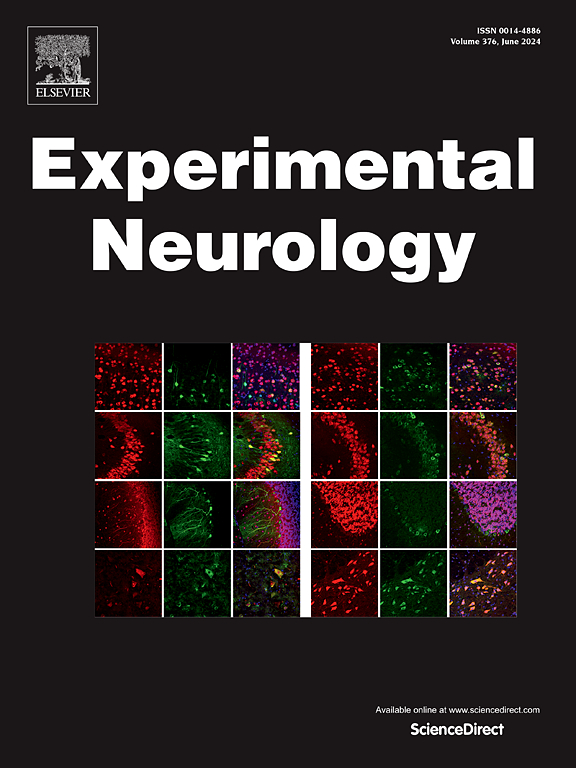Intranasal administration of stem cell-derived exosome alleviates cognitive impairment against subarachnoid hemorrhage
IF 4.6
2区 医学
Q1 NEUROSCIENCES
引用次数: 0
Abstract
Introduction
Brain damage caused by subarachnoid hemorrhage (SAH) currently lacks effective treatment, leading to stagnation in the improvement of functional outcomes for decades. Recent studies have demonstrated the therapeutic potential of exosomes released from mesenchymal stem cells (MSC), which effectively attenuate neuronal apoptosis and inflammation in neurological diseases. Due to the challenge of systemic dilution associated with intravenous administration, intranasal delivery has emerged as a novel approach for targeting the brain. In this study, we investigate the effects of intranasally administered MSC-derived exosomes in a SAH animal model and elucidate their mode of action.
Methods
Exosomes were isolated from the cell supernatants of amnion-derived MSC. SAH was induced in 8-week-old Sprague-Dawley rats using an autologous blood prechiasmatic cistern injection model. A total of 1.2 × 1010 particles of exosomes in 200 μL of PBS or PBS alone were intranasally administered immediately and 24 h post-injury. Neurological function was assessed up to 7 days after injury, and histological analysis was performed to evaluate their anti-apoptotic and anti-inflammatory effects. The biodistribution of exosomes was assessed using PET/CT imaging of 64Cu labeled exosome. In vitro analyses were performed using primary glial cells and cell lines to evaluate the anti-inflammatory effects of the exosomes.
Results
Animals treated with exosomes exhibited significant improvement in cognitive function compared with PBS treated animal. Apoptotic cells and inflammation were reduced for the exosome group in the hippocampal CA1 area and in cortex, resulting in better neuronal cell survival. Blood brain barrier permeability was also preserved in the exosome group. Nuclear imaging revealed that exosomes were primarily transferred to the olfactory nerve and cerebrum; furthermore, exosomes were also observed in the trigeminal nerve and brainstem, where exosomes were co-localized with microglia and with endothelial cells. In vitro assessment showed that exosome administration ameliorated inflammation and prevented the death of glial cells.
Conclusions
MSC-derived exosomes were successfully transferred into the brain through intranasal administration and alleviated brain damage following SAH.

鼻内给药干细胞源性外泌体可减轻蛛网膜下腔出血引起的认知障碍。
导语:蛛网膜下腔出血(SAH)引起的脑损伤目前缺乏有效的治疗方法,导致几十年来功能预后的改善停滞不前。最近的研究表明,间充质干细胞(MSC)释放的外泌体具有治疗潜力,可有效减轻神经系统疾病中的神经元凋亡和炎症。由于与静脉给药相关的全身稀释的挑战,鼻内给药已成为一种针对大脑的新方法。在这项研究中,我们研究了经鼻给药的msc来源的外泌体在SAH动物模型中的作用,并阐明了它们的作用方式。方法:从羊膜源间充质干细胞上清液中分离外泌体。采用自体血交叉前池注射模型,对8周龄Sprague-Dawley大鼠进行SAH诱导。在200 μL PBS或单独PBS中,分别在损伤后24 h和立即鼻内给药1.2 × 1010个外泌体颗粒。损伤后7 天进行神经功能评估,并进行组织学分析以评估其抗凋亡和抗炎作用。使用64Cu标记外泌体的PET/CT成像评估外泌体的生物分布。体外分析使用原代胶质细胞和细胞系来评估外泌体的抗炎作用。结果:外泌体治疗的动物与PBS治疗的动物相比,认知功能有显著改善。外泌体组海马CA1区和皮层的凋亡细胞和炎症减少,导致神经元细胞存活率提高。外泌体组也保留了血脑屏障的通透性。核成像显示外泌体主要转移到嗅觉神经和大脑;此外,在三叉神经和脑干中也观察到外泌体,外泌体与小胶质细胞和内皮细胞共定位。体外评估显示外泌体可改善炎症并防止胶质细胞死亡。结论:mscs来源的外泌体通过鼻内给药成功转移到大脑中,减轻了SAH后的脑损伤。
本文章由计算机程序翻译,如有差异,请以英文原文为准。
求助全文
约1分钟内获得全文
求助全文
来源期刊

Experimental Neurology
医学-神经科学
CiteScore
10.10
自引率
3.80%
发文量
258
审稿时长
42 days
期刊介绍:
Experimental Neurology, a Journal of Neuroscience Research, publishes original research in neuroscience with a particular emphasis on novel findings in neural development, regeneration, plasticity and transplantation. The journal has focused on research concerning basic mechanisms underlying neurological disorders.
 求助内容:
求助内容: 应助结果提醒方式:
应助结果提醒方式:


